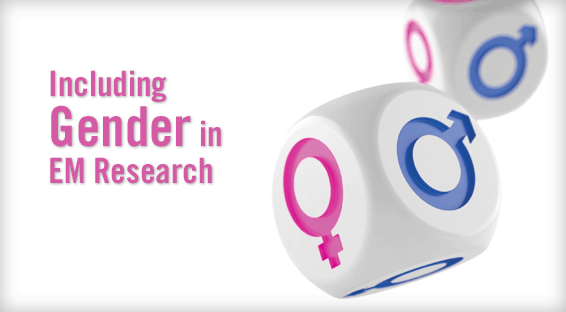Emerging data have demonstrated the value of gender-specific approaches in evaluating and managing health conditions, but it is unknown if emergency medicine (EM) has embraced the concept of ensuring that women are included in clinical research and that health outcomes are analyzed by gender. “Medical literature is filled with examples illustrating the differential effects of diseases and treatments on men and women, ranging from life-threatening conditions to public health issues,” says Basmah Safdar, MD, FACEP. “Gender medicine is not restricted to issues of women’s health and isn’t limited to reproductive organs, or the so called ‘bikini medicine.’ Emergency physicians are uniquely positioned to investigate and translate data into life-saving outcomes for both men and women.”
A Closer Look
In a study published in Academic Emergency Medicine, Dr. Safdar and colleagues assessed whether the effect of gender on health outcomes was examined in published EM studies. The majority of EM studies reviewed (79%) reported gender as part of the demographic composition of its participants. From 2006 to 2009, there was a 5% increase in the number of articles that analyzed the effect of gender on health outcomes. However, only 11% of the 750 original studies reviewed in the analysis included gender as a control variable, and 18% included gender as an independent variable. “Overall, just 2% of studies included gender in the primary hypothesis,” adds Dr. Safdar. Another 21% of EM studies did not even list the gender of participants. Use of gender in the analysis did not differ between NIH-funded studies versus non–NIH-funded studies.
More Effort Needed
“EM needs to make a more concerted effort to ensure that studies require gender-specific data,” says Dr. Safdar. “To bridge this gap, EM researchers should incorporate sex and gender as key variables in their studies, from conception to planning. A greater sensitivity to the role of sex and gender is needed in all areas of health research, including EM.” She adds that EM researchers and physicians should also strive to keep abreast of advances in all areas of research; not just EM. Some of this research has begun to shed light on the pathophysiology behind variations in disease manifestation and treatment responses that are often observed between men and women.
Dr. Safdar says that there is a need for better reporting of the gender composition of study subjects and gender-specific comparisons, regardless of whether findings are positive or negative. “Prognoses, outcomes, and interventions using gender as an independent variable should be reported in study models,” she says. “This information will help clinicians better understand how diseases manifest differently in men and women and can enhance our strategies for intervening accordingly.”




 TimH
TimH